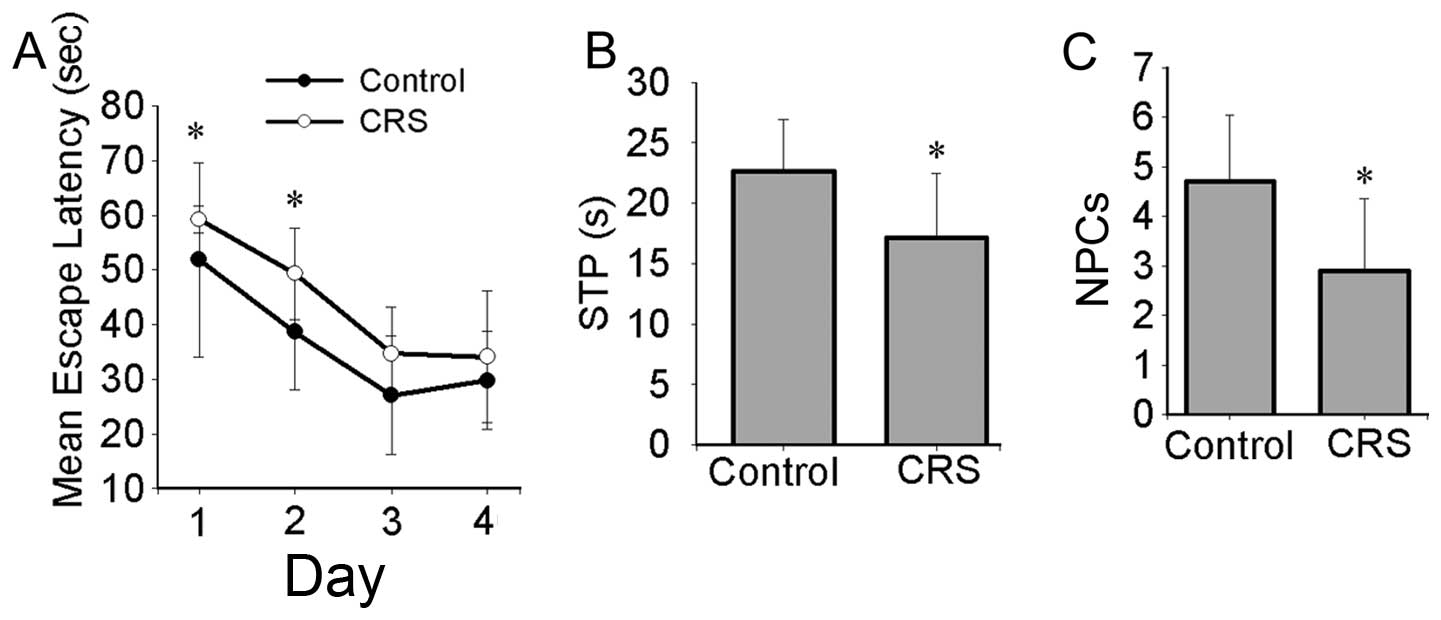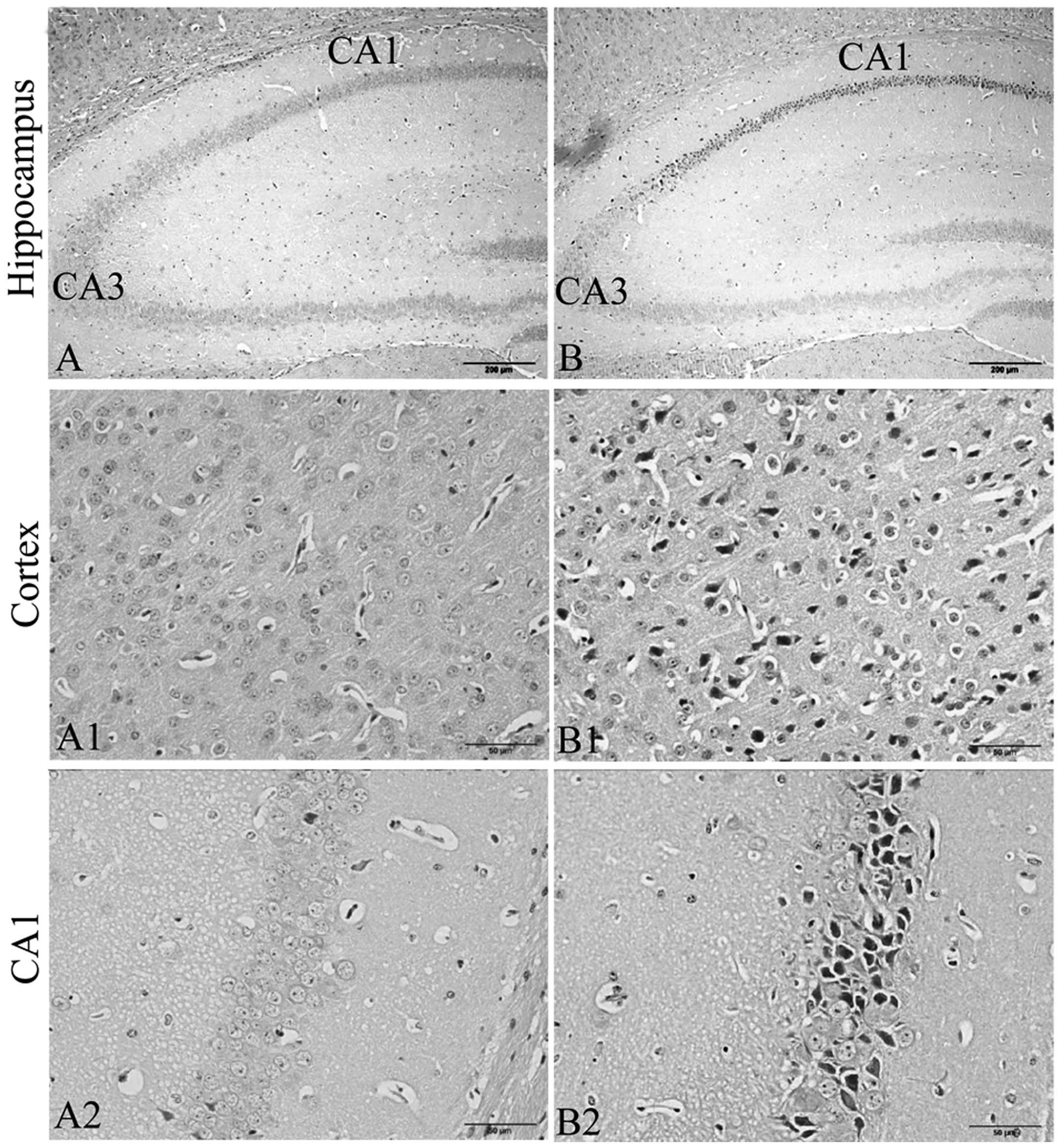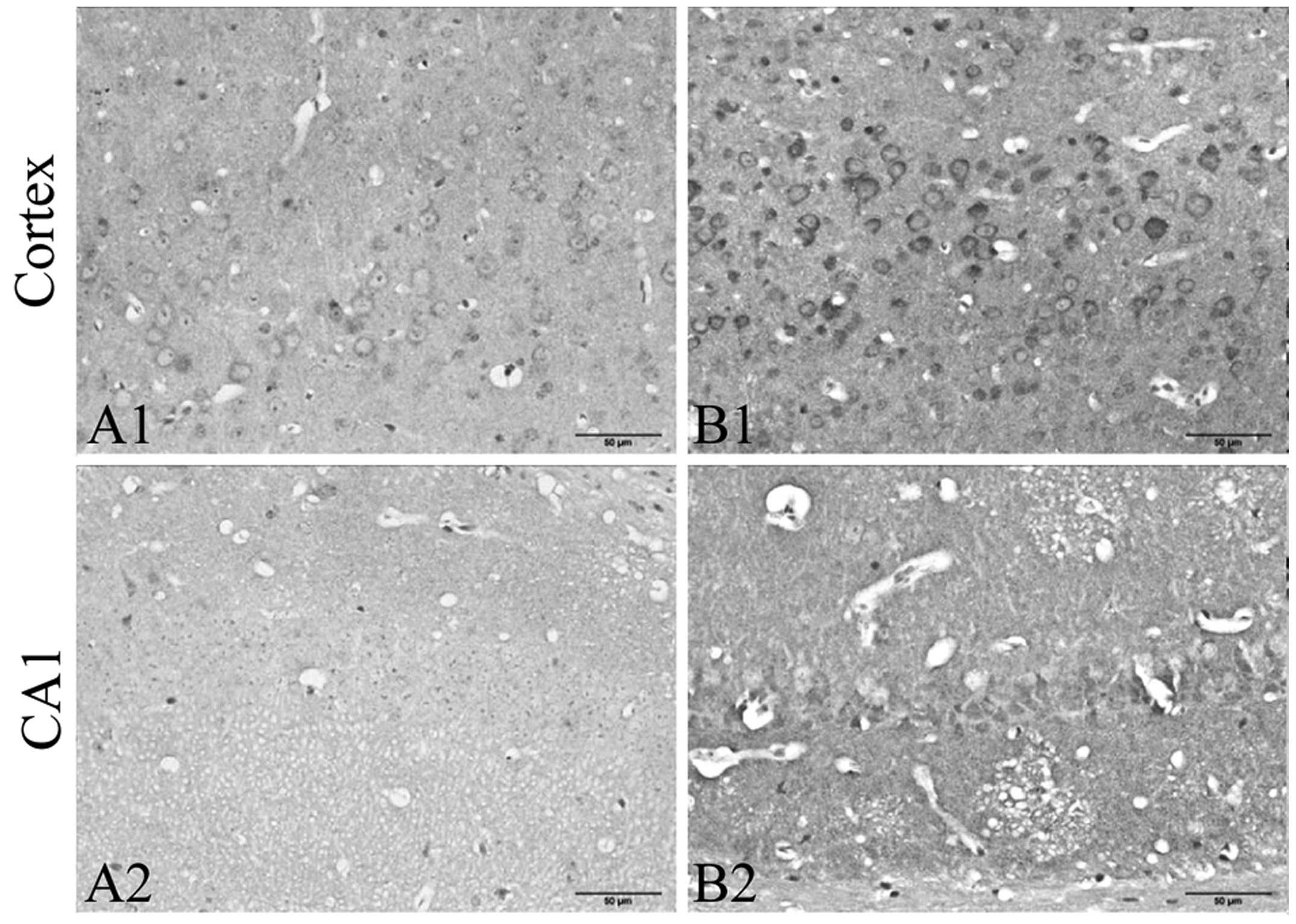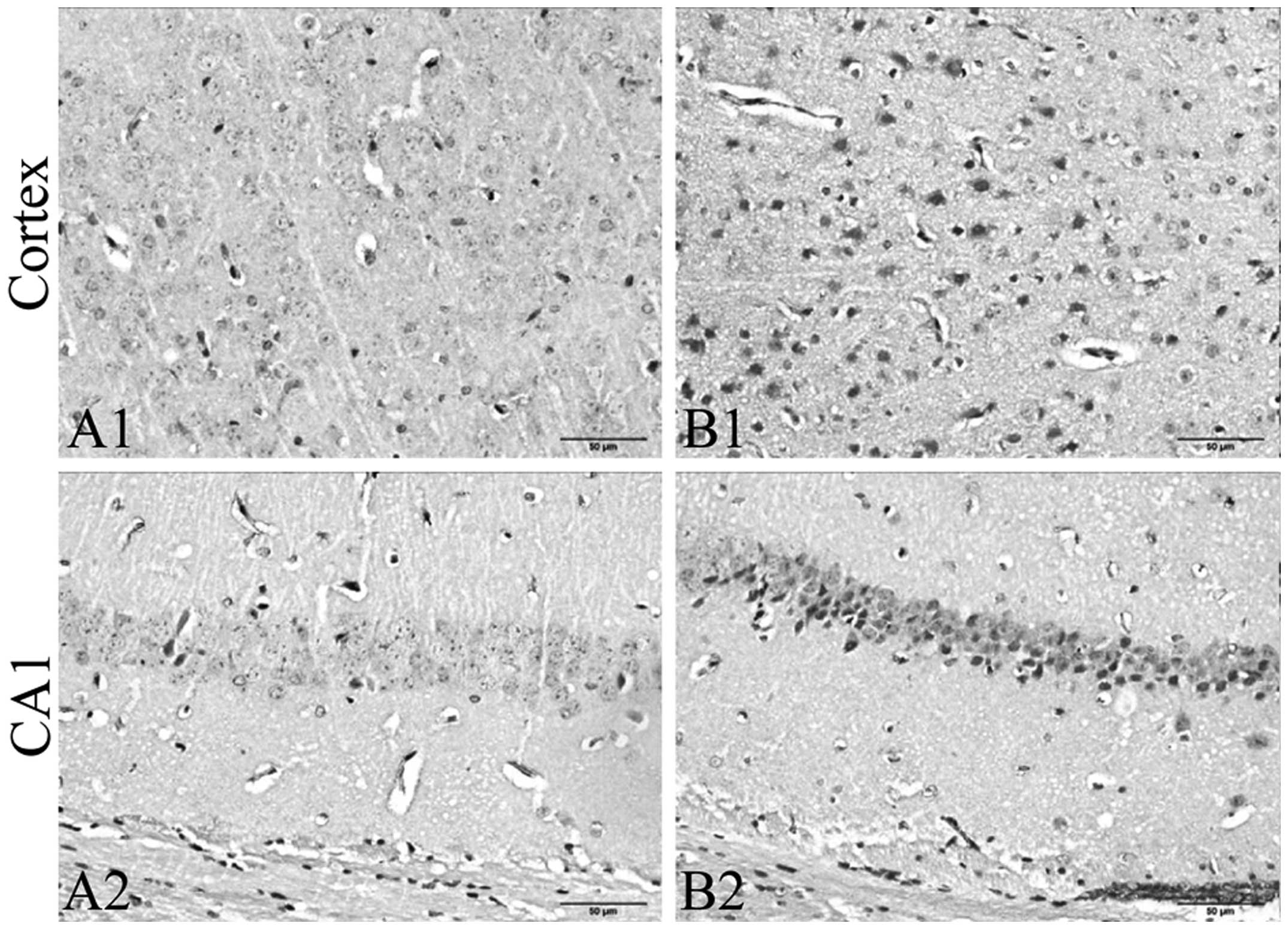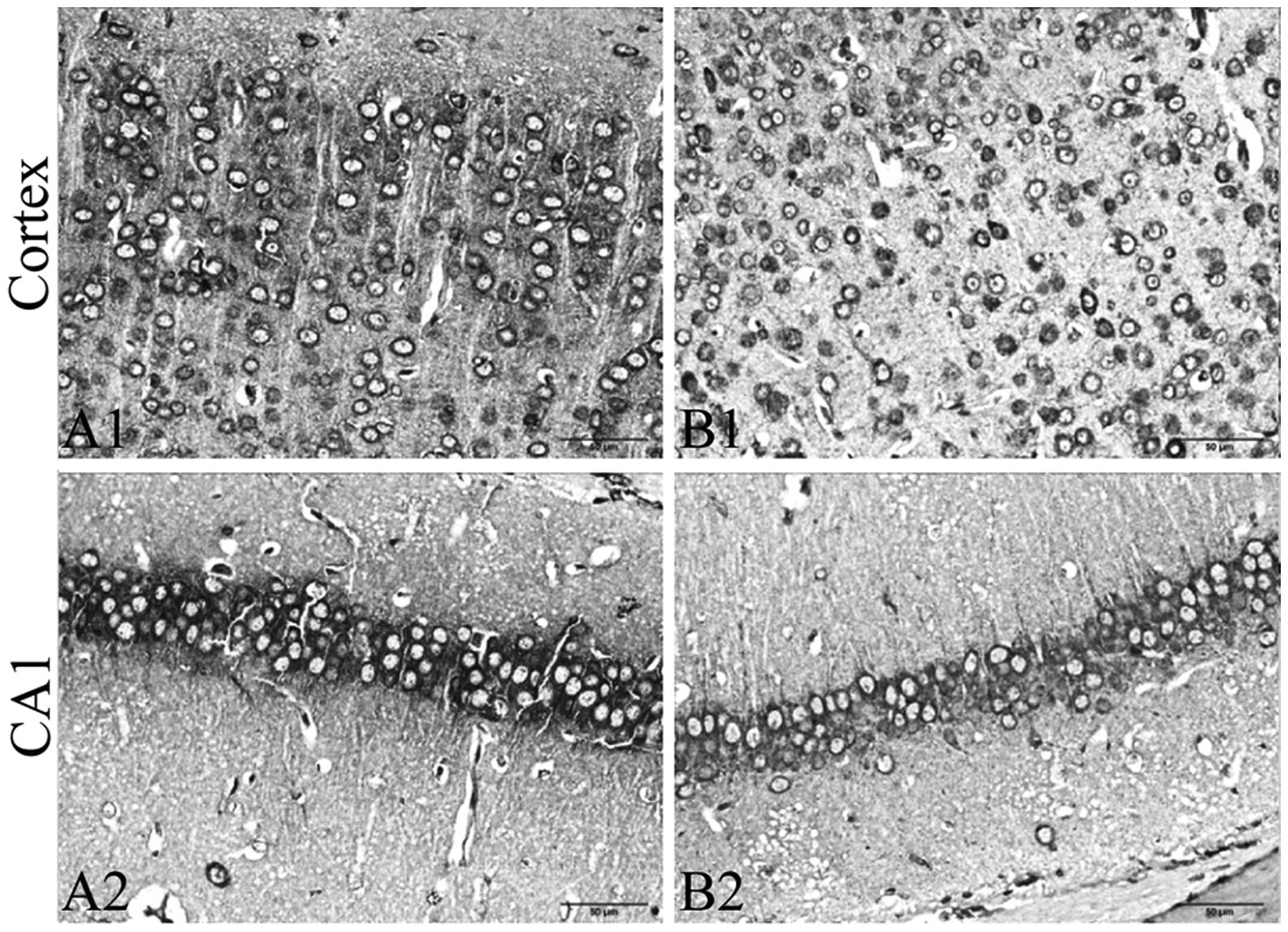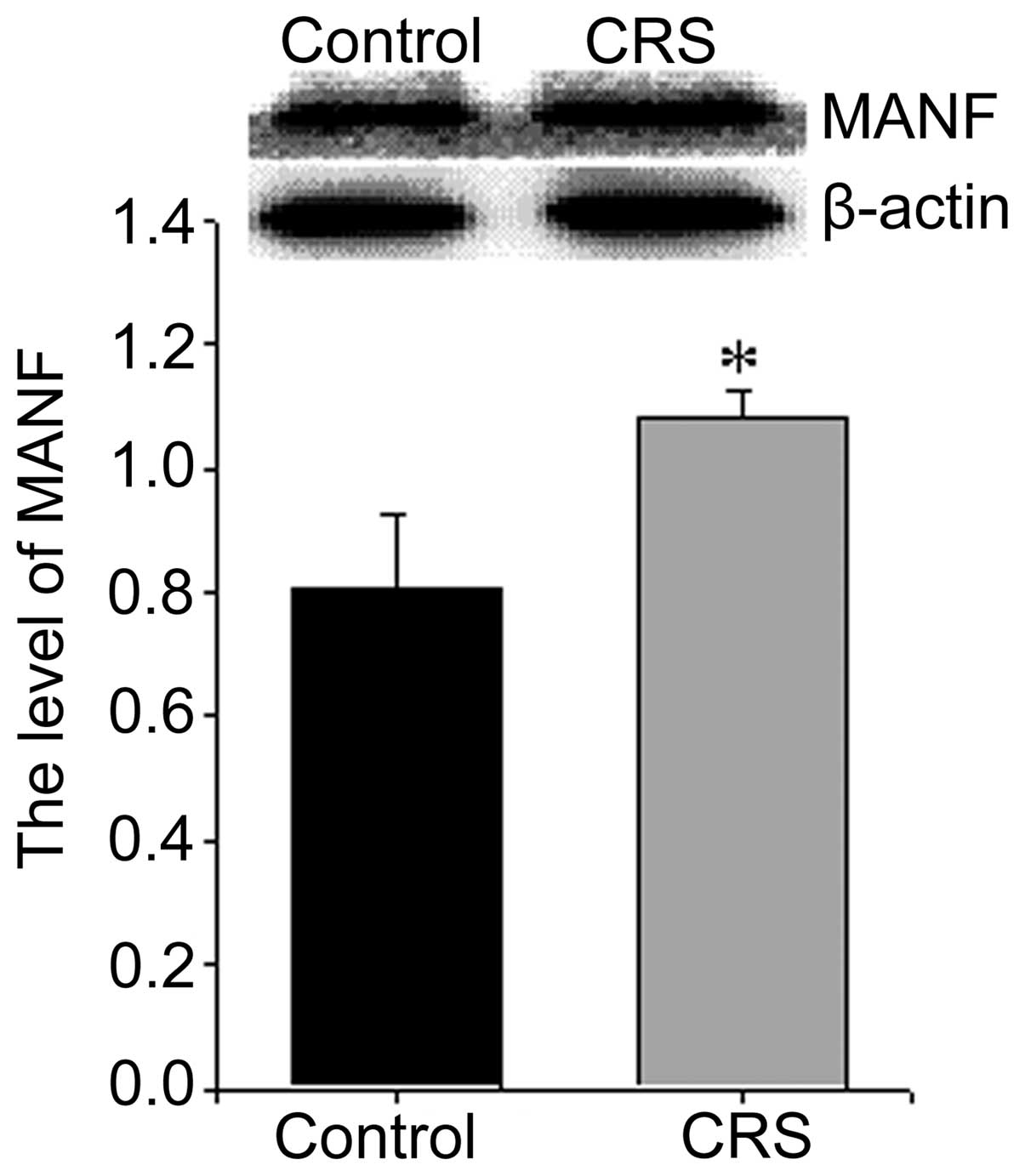Chronic restraint stress promotes learning and memory impairment due to enhanced neuronal endoplasmic reticulum stress in the frontal cortex and hippocampus in male mice
- Authors:
- Published online on: December 5, 2014 https://doi.org/10.3892/ijmm.2014.2026
- Pages: 553-559
Abstract
Introduction
Alzheimer’s disease (AD) is an age-related, progressive, irreversible neurodegenerative illness characterized by memory deficits, neuronal loss, neurofibrillary tangles (NFTs) and β-amyloid (Aβ) deposits in amyloid plaques. The etiology of AD is largely unknown; however, there is growing evidence that chronic stress may increase the risk of developing AD (1,2). Stress initiates a sequence of events in the brain and peripheral systems that enable organisms to deal with and adapt to new and challenging situations (3). However, when stress is maintained for extended periods of time, most physiological systems are negatively affected by stress (3). It has been reported that chronic stress activates hippocampal glucocorticoid receptor, increases neuronal metabolism and decreases cell survival and neurogenesis. In addition, chronic stress promotes dendritic atrophy and causes long-term potentiation and cognitive deficits (4–6). In our previous study, we demonstrated that chronic restraint stress (CRS) and stress-level dexamethasone (5 mg/kg) exposure induced learning and memory impairment and hippocampal neuronal damage in mice (7,8).
Recent studies have indicated that the endoplasmic reticulum (ER) plays an important role in maintaining neurons in neuropathological situations (9). The ER is responsible for protein folding and the transport of newly synthesized proteins. Moreover, the ER is a target for two types of intracellular stresses: ER stress and oxidative stress (10,11). ER stress response involves three different signaling pathways: unfolded protein response (UPR), ER-associated protein degradation (ERAD) and ER overload response (EOR) (9,12). Under ER stress, unfolded proteins are accumulated within the ER lumen and trigger an adaptive response which acts to restore normal ER function. However, if ER stress persists for extended periods of time and cellular homeostasis cannot be restored, the ER stress response can lead to cell apoptosis (11,13,14). ER stress has been reported in different pathophysiological conditions, including neurodegenerative diseases, such as AD (15,16). Previous studies have demonstrated that chronic stress increases the accumulation of reactive oxygen species (ROS) and induces oxidative damage in the cerebral cortex and hippocampus (8,17). However, the effects of CRS on ER stress in the frontal cortex and hippocampus have not yet been established.
The model of CRS is most popular in the study of the mechanisms of cognitive deficits induced by chronic stress (18). We hypothesized that ER stress plays an important role in the neuronal damage induced by CRS. In the present study, male mice were repeatedly exposed to CRS for 8 weeks. Cognitive function and histological damage in the frontal cortex and hippocampus were assessed using the Morris water maze and H&E staining. Furthermore, we measured the expression levels of protein kinase C (PKC)α, 78 kDa glucose-regulated protein (GRP78), mesencephalic astrocyte-derived neurotrophic factor (MANF) and C/EBP-homologous protein (CHOP) in the frontal cortex and hippocampus. The data presented in this study may contribute to a more complete understanding of the mechanisms through which chronic stress affects the development and progression of AD.
Materials and methods
Animals and treatment
The animal experiments were approved by the Committee on the Care and Use of Laboratory Animals of Anhui Medical University, Anhui, China. KM strain male mice (20–25 g) were used in this study. The animals were obtained from the Anhui Laboratory Animal Center. The mice were housed in standard cages (6 animals per cage), maintained under a 12-h dark/light cycle and provided with food and water ad libitum.
The mice were randomly divided into the control group and CRS group. The mice in the CRS group were placed in a 50-ml conical centrifuge tube with multiple punctures to allow ventilation in their home cages for 2 h per day between 14:00 to 16:00 for 8 weeks (6 days each week) as previously reported (19,20). The mice in the control group were not subjected to stress and were allowed unrestricted access to food and water.
Morris water maze test
The Morris water maze test was carried out as previously described (21). The Morris water maze consisted of a black circular pool (diameter, 120 cm; height, 60 cm) filled with water and the pool was divided into 4 quadrants. The animals (10 mice in each group) were placed into the pool (facing the wall of the pool) and were allowed to circumnavigate the pool in search of the escape platform (in the center of a quadrant submerged 2 cm below the water surface) for 4 trials (60 sec per trial) per day from day 52 to 55 during exposure to CRS. The escape latency (sec) was recorded to indicate the learning results. After the final trial, the platform was removed from the tank and each mouse was subjected to a 60-sec swim probe test. The number of platform crossings (NPCs) and the swimming time in the quadrant of the platform (STP) were recorded to indicate the memory results.
Histological examination
Twenty-four hours after the final exposure to restraint stress, the animals were sacrificed by cervical dislocation. The brains were removed (5 animals in each group) and fixed in 4% paraformaldehyde and embedded in paraffin. The brain was cut into 5 μm-thick sections using a section cutter (Leica Biosystems, Wetzlar, Germany). The sections were stained with hematoxylin and eosin (H&E) and examined under a light microscope (Olympus IX71; Olympus, Tokyo, Japan).
Immunohistochemistry
The brain paraffin sections were passed through a gradient of xylene and ethyl alcohol to hydrate the tissue (5 sections in each group). The sections were treated with 0.3% hydrogen peroxide to block endogenous peroxidase activity, then washed with PBS. The sections were treated with primary antibody overnight at 4°C. The primary antibodies to PKCα (BS646; 1:200), GRP78 (BS6479; 1:200), CHOP (BS6814; 1:200) were from Bioworld Technology Co. The sections were incubated with a biotinylated anti-rabbit secondary antibody and subjected to diaminobenzidine oxidation using the ABC kit (Zhongshan Golden Bridge Biotechnology Co., Ltd., Beijing, China). The sections were re-stained with hematoxylin and examined under a microscope (Olympus IX71). The positive cells were stained brown. Three non-overlapping fields (×400) in each area of the hippocampus CA1 region and the frontal cortex of each section were analyzed in a blinded manner. The integral optical density of immunopositive neurons in each section was measured using the JD801 Image analysis system (Jiangsu Jieda Technology, Jiangsu, China) to indicate the expression of PKCα, GRP78 and CHOP.
Immunoblot analysis
Protein was extracted from the frozen tissue of the frontal cortex and hippocampus (4 animals in each group). The protein concentration was determined using the BCA Protein Assay kit (Shanghai Sangon Biotechnology, Shanghai, China) and equal amounts of protein were separated by SDS-PAGE and transferred onto PVDF membranes. The membranes were blocked at room temperature for 1 h with 5% dry skim milk in Tris-buffered saline containing 1% Tween-20 (TBS-T). The membranes were treated with antibodies to GRP78, CHOP and MANF (provided by Professor Yuxian Shen, Anhui Medical University) and β-actin (1:1,000) overnight at 4°C. The membranes were then incubated with anti-rabbit IgG antibody conjugated to HRP (1:10,000) for 1 h. After extensive washes, the protein bands were detected using chemiluminescence reagents (ECL kit; Amersham Biosciences, Little Chalfont, UK). The Tanon4500 Imaging System (Shanghai Tanon Technology, Shanghai, China) was used to visualize the protein bands, and densitometry was performed using ImageJ software. The relative density of the immunoreactive bands was normalized to the density of the corresponding bands of β-actin.
Data analysis
The data were analyzed by using SPSS 16.0 statistical analysis software. Statistical differences between the two treatment groups were determined using an unpaired two-tailed Student’s t-test, and a value of P<0.05 was considered to indicate a statistically significant difference. Data are presented as the means ± SD.
Results
CRS accelerates behavioral impairment in male mice
In the memory training experiment, the mean escape latencies (day 1 and 2) differed significantly between the 2 groups (day 1, 51.85.±17.74 vs. 59.19±2.44 sec; day 2, 38.65±10.70 vs. 49.35±8.36 sec for mice in the control group and mice exposed to CRS, respectively) (Fig. 1A). In the probe trial, the average number of platform crossings (NPCs) and the swimming time in the quadrant of the platform (STP) also differed significantly between the 2 groups (NPCs, 4.70±1.34 vs. 2.90±1.45; STP, 22.62±4.36 vs. 17.19±5.32 STP for mice in the control group and mice exposed to CRS, respectively) (Fig. 1B and C).
CRS enhances neuronal degeneration in the frontal cortex and hippocampus CA1 region
In order to investigate the effects of chronic stress on cortical and hippocampal neurons, we examined the neuronal histomorphological changes in the frontal cortex and hippocampus (Fig. 2). In the control group mice, no obvious neuronal abnormalities were observed in the frontal cortex and hippocampus CA1 region (Fig. 2A, A1 and A2). However, in the CRS group, more degenerative neurons were observed in the frontal cortex and hippocampus CA1 region (Fig. 2B, B1 and B2). Acidophilic degeneration and nuclear pyknosis was observed.
Effects of CRS on the expression of PKCα, GRP78, CHOP and MANF in the frontal cortex and hippocampus
To evaluate the effects of CRS on ER stress, we detected the expression of PKCα, GRP78 and CHOP in the frontal cortex and hippocampus by immunohistochemistry. We further detected the expression of MANF, GRP78 and CHOP in the tissue of the frontal cortex and hippocampus by immunoblot analysis. The results from immunohistochemistry revealed that exposure to CRS significantly increased the expression of PKCα (Fig. 3) and CHOP (Fig. 4A–C), and decreased the expression of GRP78 (Fig. 5A–C) in the frontal cortex and hippocampus CA1 region. The results of immunoblot analysis revealed that exposure to CRS significantly increased the expression of MANF (Fig. 6) and CHOP (Fig. 4D) and decreased the expression of GRP78 (Fig. 5D).
Discussion
The results of the present study demonstrated that exposure to CRS for 8 weeks caused a significant impairment in cognitive function and neuronal damage in the frontal cortex and hippocampus CA1 region of male mice. Moreover, exposure to CRS (for 8 weeks) significantly increased the expression of PKCα, CHOP and MANF, decreased the expression of GRP78. To the best of our knowledge, this is the first study to describe the effects of chronic stress on ER stress in the frontal cortex and hippocampus.
Chronic stress has been reported to be associated with many neurodegenerative diseases, such as depression, AD and Parkinson’s disease (22–24). The chronic stress-induced neurodegenerative diseases are an outcome of different mechanisms, such as central neurotransmitters, neurohormonal factors, particularly those linked with the hypothalamic-pituitary-adrenal (HPA) axis and free radical generation (25,26). It has been reported that exposure to acute restraint stress (150 min of immobilization) significantly increases neuronal damage in the frontal cortex and striatum both at 1 and 24 h following exposure to restraint stress (27). The present study demonstrated that exposure to CRS for 8 weeks caused a significant impairment in cognitive function and neuronal damage in the frontal cortex and hippocampus CA1 region in male mice. However, it remains unclear as to whether ER stress is involved in chronic stress-induced learning and memory impairment.
ER stress is originally an adaptive response that can be induced by various stimuli during normal ER function, such as the accumulation of unfolded or misfolded proteins and changes in ER Ca2+ homeostasis. ER stress triggers the activation of several signaling pathways to cope with the abnormal load in the ER lumen (28). The UPR pathway induces the upregulation of ER chaperones, such as GRP78 and the EOR pathway induces the activation of nuclear factor-κB (NF-κB), leading to the production of cytokines (29). However, ER stress may also contribute to cell suicide when abnormalities become extensive (30). Furthermore, studies have demonstrated that ER stress may play an important role in the development of neurodegenerative diseases (13) and ER stress may occur prior to neuronal cell death (31–33). Previous studies have also reported that oxidative stress contributes to ER stress (33–35). In our previous study, we demonstrated that exposure to CRS increased ROS accumulation and induced oxidative damage in the cerebral cortex and hippocampus (8). This suggests that ER stress is involved in the oxidative damage induced by chronic stress in the frontal cortex and hippocampus.
The activation of PKC isoforms has been shown to be associated with ER stress (28,36). PKC is involved in the induction of GRP78 (37), a major ER chaperone and a crucial regulator of ER homeostasis. PKCα, a classic PKC isoform, has been reported to mediate growth arrest in human embryonal rhabdomyosarcoma cells by inducing the activation of JNKs, p38 kinase and ERKs (38), which are involved in the induction of ER stress (37,39). GRP78 is a molecular chaperone only located in the ER. GRP78 facilitates protein folding, stabilizes calcium homeostasis and protects cells against oxidative stress and apoptotic death (40,41). With ER stress, the level of the ER marker, GRP78, has been shown to increase in a time-dependent manner, peaking at 24 h and decreasing at 48 h (42). CHOP, also known as growth arrest and DNA damage-inducible gene 153 (GADD153), is an important mediator of ER stress-induced cell death (43). CHOP is expressed at low levels under physiological conditions. It is upregulated during severe and prolonged ER stress and plays a crucial role in cell arrest and apoptosis (44,45). In a previous study, the apoptotic initiator, CHOP, showed the highest level at 48 h during ER stress (42). MANF is also an ER stress responsive protein with neuroprotective effects in animal models of neurodegeneration. ER stress can cause the upregulation of MANF (46). In the present study, we found that exposure to CRS significantly increased the expression of PKCα, CHOP and MANF, and decreased the expression of GRP78 in the frontal cortex and hippocampus CA1 region. These data suggest that CRS induces the ER overload response in the cortex and hippocampus. Furthermore, ER-resident proteins, such as GRP78 are susceptible to oxidative damage (47). Oxidation of the ER proteins may dissociate GRP78 and cause further activation of the ER stress signals (48). CRS can promote ROS accumulation, which may dissociate GRP78 and induce the decrease of GRP78 in the frontal cortex and hippocampus.
In conclusion, to the best of our knowledge, the present study demonstrates for the first time that ER stress may be involved in the impairment of cognitive function and neuronal damage in the frontal cortex and hippocampus induced by CRS. It should be noted that the present study only examined the effects of CRS on cognitive function, neuronal damage and the expression of PKCα, GRP78, CHOP and MANF in the frontal cortex and hippocampus. The close interaction between chronic stress and ER warrants further investigation. Despite its preliminary character, this study clearly indicates that ER stress is implicated in the learning and memory impairment induced by CRS. Manipulation of the ER stress pathway signals may provide novel therapeutic interventions for chronic stress-related neurodegenerative diseases, such as AD.
Acknowledgments
The authors are grateful for the support provided by the National Natural Science Foundation of China (81173624) and the Doctor Foundation of Anhui Medical University (XJ201011). They also would like to thank Dake Huang, Shan Huang and Li Gui (Synthetic Laboratory of Basic Medicine College, Anhui Medical University) for their excellent technical assistance.
References
|
Wilson RS, Evans DA, Bienias JL, Mendes de Leon CF, Schneider JA and Bennett DA: Proneness to psychological distress is associated with risk of Alzheimer’s disease. Neurology. 61:1479–1485. 2003. View Article : Google Scholar : PubMed/NCBI | |
|
Csernansky JG, Dong H, Fagan AM, et al: Plasma cortisol and progression of dementia in subjects with Alzheimer-type dementia. Am J Psychiatry. 163:2164–2169. 2006. View Article : Google Scholar : PubMed/NCBI | |
|
Sandi C: Stress, cognitive impairment and cell adhesion molecules. Nat Rev Neurosci. 5:917–930. 2004. View Article : Google Scholar : PubMed/NCBI | |
|
McEwen BS and Magarinos AM: Stress and hippocampal plasticity: implications for the pathophysiology of affective disorders. Hum Psychopharmacol. 16:S7–S19. 2001. View Article : Google Scholar | |
|
Kim JJ and Diamond DM: The stressed hippocampus, synaptic plasticity and lost memories. Nat Rev Neurosci. 3:453–462. 2002.PubMed/NCBI | |
|
Rothman SM and Mattson MP: Adverse stress, hippocampal networks, and Alzheimer’s disease. Neuromolecular Med. 12:56–70. 2010. View Article : Google Scholar : | |
|
Li WZ, Li WP, Yao YY, et al: Glucocorticoids increase impairments in learning and memory due to elevated amyloid precursor protein expression and neuronal apoptosis in 12-month old mice. Eur J Pharmacol. 628:108–115. 2010. View Article : Google Scholar | |
|
Wang Y, Kan H, Yin Y, et al: Protective effects of ginsenoside Rg1 on chronic restraint stress induced learning and memory impairments in male mice. Pharmacol Biochem Behav. 120:73–81. 2014. View Article : Google Scholar : PubMed/NCBI | |
|
Ansari N and Khodagholi F: Molecular mechanism aspect of ER stress in Alzheimer’s disease: current approaches and future strategies. Curr Drug Targets. 14:114–122. 2013. View Article : Google Scholar | |
|
Schroder M and Kaufman RJ: The mammalian unfolded protein response. Annu Rev Biochem. 74:739–789. 2005. View Article : Google Scholar : PubMed/NCBI | |
|
Lin JH, Li H, Yasumura D, et al: IRE1 signaling affects cell fate during the unfolded protein response. Science. 318:944–949. 2007. View Article : Google Scholar : PubMed/NCBI | |
|
Minamino T and Kitakaze M: ER stress in cardiovascular disease. J Mol Cell Cardiol. 48:1105–1110. 2010. View Article : Google Scholar | |
|
Nakagawa T, Zhu H, Morishima N, et al: Caspase-12 mediates endoplasmic-reticulum-specific apoptosis and cytotoxicity by amyloid-beta. Nature. 403:98–103. 2000. View Article : Google Scholar : PubMed/NCBI | |
|
Marciniak SJ, Yun CY, Oyadomari S, et al: CHOP induces death by promoting protein synthesis and oxidation in the stressed endoplasmic reticulum. Genes Dev. 18:3066–3077. 2004. View Article : Google Scholar : PubMed/NCBI | |
|
Katayama T, Imaizumi K, Manabe T, Hitomi J, Kudo T and Tohyama M: Induction of neuronal death by ER stress in Alzheimer’s disease. J Chem Neuroanat. 28:67–78. 2004. View Article : Google Scholar : PubMed/NCBI | |
|
Costa RO, Ferreiro E, Martins I, et al: Amyloid beta-induced ER stress is enhanced under mitochondrial dysfunction conditions. Neurobiol Aging. 33:824.e5–824.e16. 2012. View Article : Google Scholar | |
|
Moceri VM, Kukull WA, Emanuel I, van Belle G and Larson EB: Early-life risk factors and the development of Alzheimer’s disease. Neurology. 54:415–420. 2000. View Article : Google Scholar : PubMed/NCBI | |
|
Liu Y, Zhuang X, Gou L, et al: Protective effects of nizofenone administration on the cognitive impairments induced by chronic restraint stress in mice. Pharmacol Biochem Behav. 103:474–480. 2013. View Article : Google Scholar | |
|
Yin D, Tuthill D, Mufson RA and Shi Y: Chronic restraint stress promotes lymphocyte apoptosis by modulating CD95 expression. J Exp Med. 191:1423–1428. 2000. View Article : Google Scholar : PubMed/NCBI | |
|
Derin N, Yargicoglu P, Aslan M, Elmas O, Agar A and Aiciguzel Y: The effect of sulfite and chronic restraint stress on brain lipid peroxidation and anti-oxidant enzyme activities. Toxicol Ind Health. 22:233–240. 2006. View Article : Google Scholar : PubMed/NCBI | |
|
Yin Y, Ren Y, Wu W, et al: Protective effects of bilobalide on Aβ(25–35) induced learning and memory impairments in male rats. Pharmacol Biochem Behav. 106:77–84. 2013. View Article : Google Scholar : PubMed/NCBI | |
|
Vanitallie TB: Stress: a risk factor for serious illness. Metabolism. 51:40–45. 2002. View Article : Google Scholar : PubMed/NCBI | |
|
Kaufman D, Banerji MA, Shorman I, et al: Early-life stress and the development of obesity and insulin resistance in juvenile bonnet macaques. Diabetes. 56:1382–1386. 2007. View Article : Google Scholar : PubMed/NCBI | |
|
Pittenger C and Duman RS: Stress, depression, and neuroplasticity: a convergence of mechanisms. Neuropsychopharmacology. 33:88–109. 2008. View Article : Google Scholar | |
|
Zafir A and Banu N: Modulation of in vivo oxidative status by exogenous corticosterone and restraint stress in rats. Stress. 12:167–177. 2009. View Article : Google Scholar | |
|
Jankord R and Herman JP: Limbic regulation of hypothalamo-pituitary-adrenocortical function during acute and chronic stress. Ann NY Acad Sci. 1148:64–73. 2008. View Article : Google Scholar | |
|
Ahmad A, Rasheed N, Ashraf GM, et al: Brain region specific monoamine and oxidative changes during restraint stress. Can J Neurol Sci. 39:311–318. 2012. View Article : Google Scholar : PubMed/NCBI | |
|
Kuo TC, Huang WJ and Guh JH: WJ9708012 exerts anticancer activity through PKC-α related crosstalk of mitochondrial and endoplasmic reticulum stresses in human hormone-refractory prostate cancer cells. Acta Pharmacol Sin. 32:89–98. 2011. View Article : Google Scholar | |
|
Wang XZ, Lawson B, Brewer JW, et al: Signals from the stressed endoplasmic reticulum induce C/EBP-homologous protein (CHOP/GADD153). Mol Cell Biol. 16:4273–4280. 1996.PubMed/NCBI | |
|
Groenendyk J and Michalak M: Endoplasmic reticulum quality control and apoptosis. Acta Biochim Pol. 52:381–395. 2005.PubMed/NCBI | |
|
Watts LT, Rathinam ML, Schenker S and Henderson GI: Astrocytes protect neurons from ethanol-induced oxidative stress and apoptotic death. J Neurosci Res. 80:655–666. 2005. View Article : Google Scholar : PubMed/NCBI | |
|
Loh KP, Huang SH, De Silva R, Tan BK and Zhu YZ: Oxidative stress: apoptosis in neuronal injury. Curr Alzheimer Res. 3:327–337. 2006. View Article : Google Scholar : PubMed/NCBI | |
|
Wu M, Yang S, Elliott MH, et al: Oxidative and endoplasmic reticulum stresses mediate apoptosis induced by modified LDL in human retinal Müller cells. Invest Ophthalmol Vis Sci. 53:4595–4604. 2012. View Article : Google Scholar : PubMed/NCBI | |
|
Xu C, Bailly-Maitre B and Reed JC: Endoplasmic reticulum stress: cell life and death decisions. J Clin Invest. 115:2656–2664. 2005. View Article : Google Scholar : PubMed/NCBI | |
|
Park GB, Kim YS, Lee HK, et al: Endoplasmic reticulum stress-mediated apoptosis of EBV-transformed B cells by cross-linking of CD70 is dependent upon generation of reactive oxygen species and activation of p38 MAPK and JNK pathway. J Immunol. 185:7274–7284. 2010. View Article : Google Scholar : PubMed/NCBI | |
|
Pino SC, O'Sullivan-Murphy B, Lidstone EA, et al: Protein kinase C signaling during T cell activation induces the endoplasmic reticulum stress response. Cell Stress Chaperones. 13:421–434. 2008. View Article : Google Scholar : PubMed/NCBI | |
|
Lien YC, Kung HN, Lu KS, Jeng CJ and Chau YP: Involvement of endoplasmic reticulum stress and activation of MAP kinases in beta-lapachone-induced human prostate cancer cell apoptosis. Histol Histopathol. 23:1299–1308. 2008.PubMed/NCBI | |
|
Mauro A, Ciccarelli C, De Cesaris P, et al: PKCα-mediated ERK, JNK and p38 activation regulates the myogenic program in human rhabdomyosarcoma cells. J Cell Sci. 115:3587–3599. 2002. View Article : Google Scholar : PubMed/NCBI | |
|
Song MS, Park YK, Lee JH and Park K: Induction of glucose-regulated protein 78 by chronic hypoxia in human gastric tumor cells through a protein kinase C-epsilon/ERK/AP-1 signaling cascade. Cancer Res. 61:8322–8330. 2001.PubMed/NCBI | |
|
Liu H, Bowes RC III, van de Water B, Sillence C, Nagelkerke JF and Stevens JL: Endoplasmic reticulum chaperones GRP78 and calreticulin prevent oxidative stress, Ca2+ disturbances, and cell death in renal epithelial cells. J Biol Chem. 272:21751–21759. 1997. View Article : Google Scholar : PubMed/NCBI | |
|
Yu Z, Luo H, Fu W and Mattson MP: The endoplasmic reticulum stress-responsive protein GRP78 protects neurons against excitotoxicity and apoptosis: suppression of oxidative stress and stabilization of calcium homeostasis. Exp Neurol. 155:302–314. 1999. View Article : Google Scholar : PubMed/NCBI | |
|
Yin QQ, Dong CF, Dong SQ, et al: AGEs induce cell death via oxidative and endoplasmic reticulum stresses in both human SH-SY5Y neuroblastoma cells and rat cortical neurons. Cell Mol Neurobiol. 32:1299–1309. 2012. View Article : Google Scholar : PubMed/NCBI | |
|
Szegezdi E, Logue SE, Gorman AM and Samali A: Mediators of endoplasmic reticulum stress-induced apoptosis. EMBO Rep. 7:880–885. 2006. View Article : Google Scholar : PubMed/NCBI | |
|
Oyadomari S and Mori M: Roles of CHOP/GADD153 in endoplasmic reticulum stress. Cell Death Differ. 11:381–389. 2004. View Article : Google Scholar | |
|
Tajiri S, Oyadomari S, Yano S, et al: Ischemia-induced neuronal cell death is mediated by the endoplasmic reticulum stress pathway involving CHOP. Cell Death Differ. 11:403–415. 2004. View Article : Google Scholar : PubMed/NCBI | |
|
Parkash V, Lindholm P, Peranen J, et al: The structure of the conserved neurotrophic factors MANF and CDNF explains why they are bifunctional. Protein Eng Des Sel. 22:233–241. 2009. View Article : Google Scholar : PubMed/NCBI | |
|
Hayashi T, Saito A, Okuno S, Ferrand-Drake M, Dodd RL and Chan PH: Oxidative injury to the endoplasmic reticulum in mouse brains after transient focal ischemia. Neurobiol Dis. 15:229–239. 2004. View Article : Google Scholar : PubMed/NCBI | |
|
Rabek JP, Boylston WH III and Papaconstantinou J: Carbonylation of ER chaperone proteins in aged mouse liver. Biochem Biophys Res Commun. 305:566–572. 2003. View Article : Google Scholar : PubMed/NCBI |



